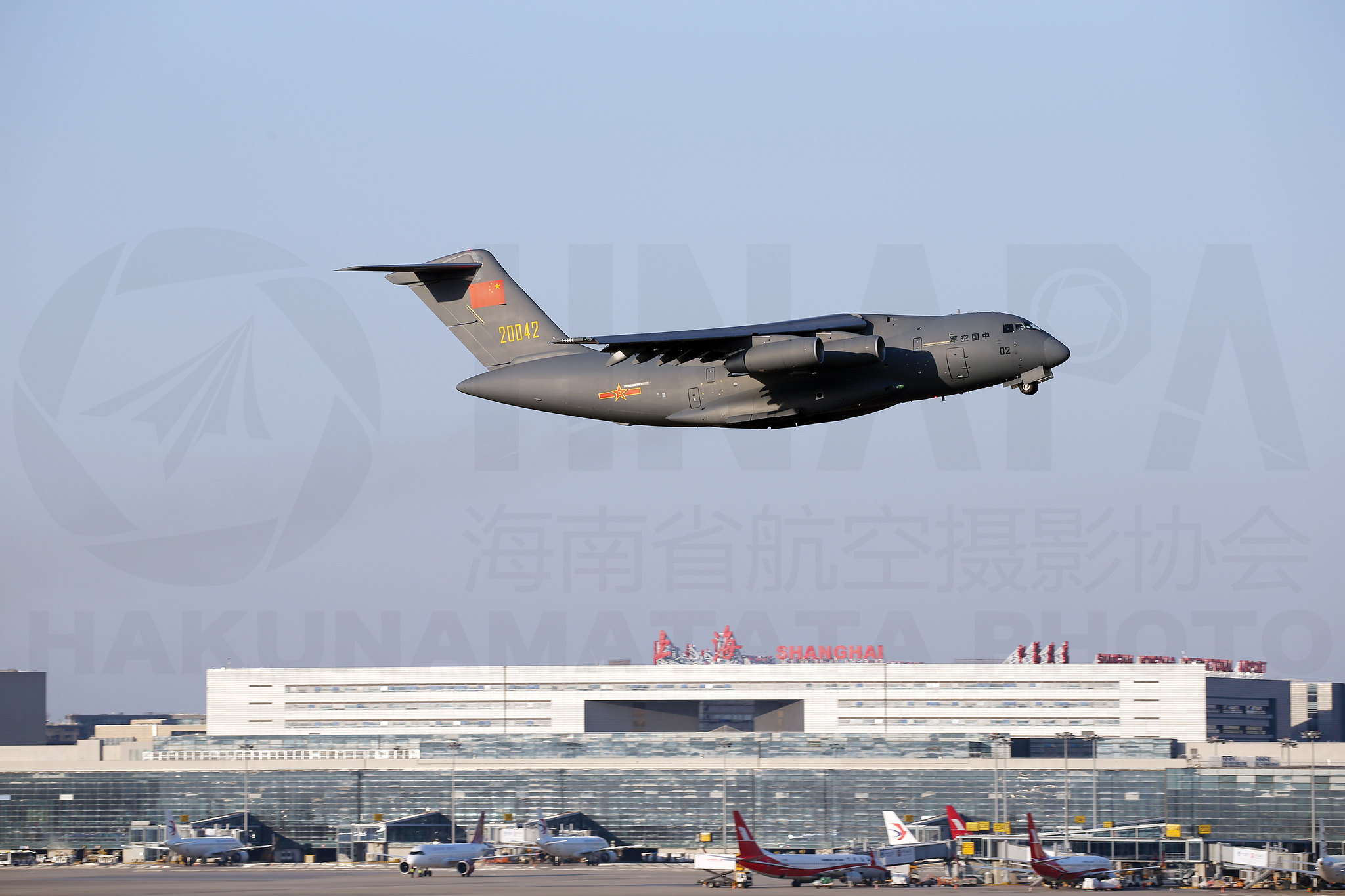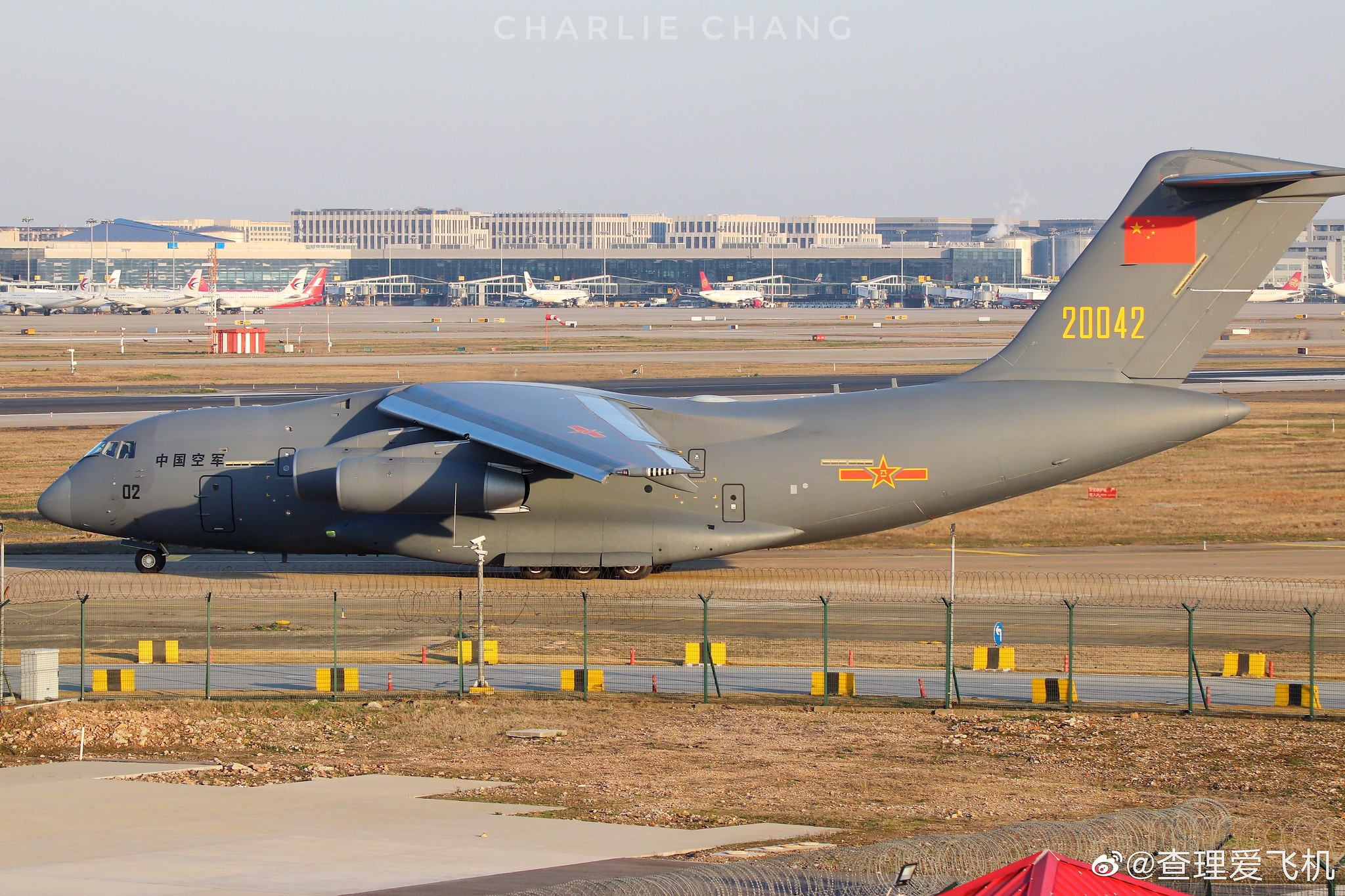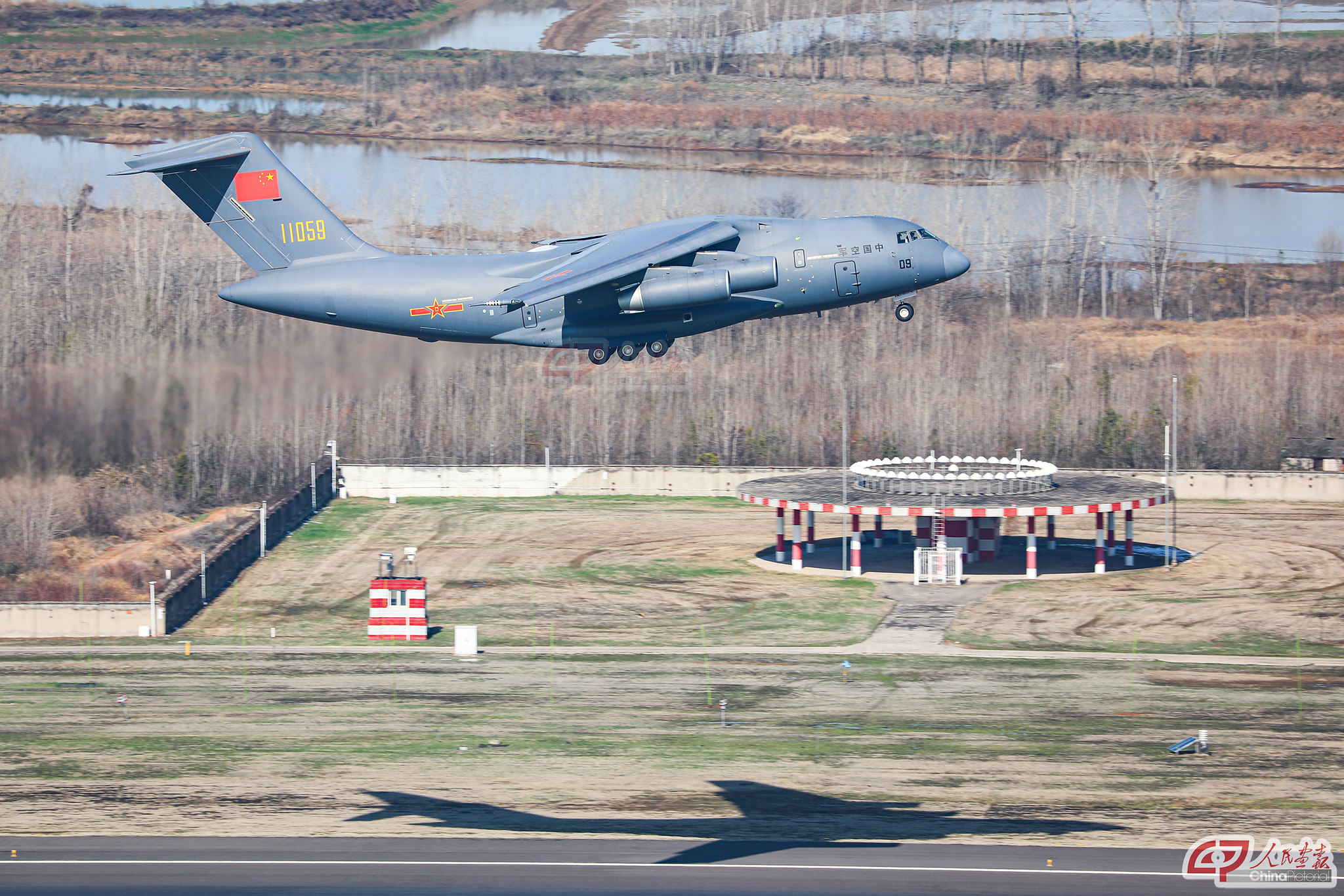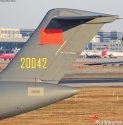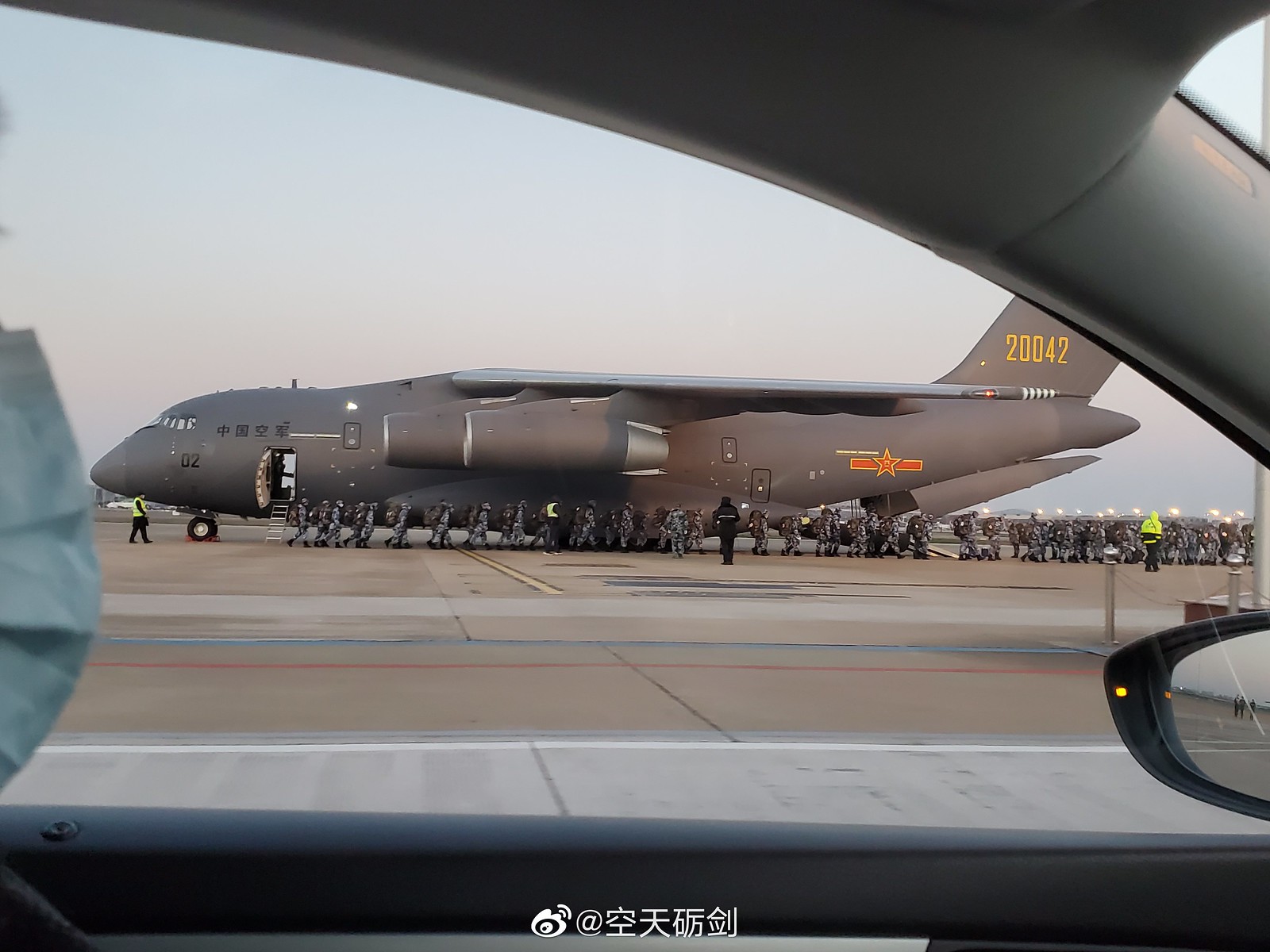You are using an out of date browser. It may not display this or other websites correctly.
You should upgrade or use an alternative browser.
You should upgrade or use an alternative browser.
China's transport, tanker & heavy lift aircraft - esp. Y-20/YY-20
- Thread starter Totoro
- Start date
Hendrik_2000
Lieutenant General
China definitely improve their air transport capability Here is Henri K assessment on recent MOOTW deployment of Y 20
He considered it a success.
Six Y-20 in Wuhan: analysis of the first figures
BY
For China's security and defense observers, 2020 was off to a good start with a series of admissions to active service by the Chinese Navy. But the spread since mid-January of the 2019-nCoV coronavirus, now renamed CODIV-19 by the WHO, has literally saturated all the media around the world, including and especially in China, while the disease has affected far fewer people compared to the flu - As an example, there are already at least 26 million cases of influenza, 250,000 hospitalizations and 14,000 deaths in the United States since last September, according (CDC).
In this "dark" and strange time, if there is no shortage of news about the Chinese army ( We now know that the Chinese army is almost omnipresent in the search for solutions to identify and fight against the disease, and especially on the ground also to reinforce the civilian medical teams on the spot, very fragile given the scale of this epidemic ), they are especially focused on the "value of man" and the mobilization of the military medical forces in this event, and very little on the technical means deployed.
But that changes with the deployment of 11 military transport planes last Thursday in a large-scale transport operation bound for Wuhan. This event in fact gives an unexpected opportunity to study closely the capacity and the performance of the Y-20, thanks to the numerous publications produced by institutional press organs.
Since a little over 3 years ago, in July 2016, this locally designed heavy transport aircraft has shown little, or not enough, to the public, not to mention the technical data that is rarely revealed.
Six Y-20s in one MOOTW operation
As far as we know, this air operation dated Thursday, February 13, 2020 is part of an additional measure recently decided by the Chinese government and the Central Military Commission (CMC), to help the city of Wuhan. and Hubei province with medical reinforcements in men and materials.
In summary, the Chinese Air Force had mobilized 11 of its military transport aircraft in the operation, including six Y-20s, three IL-76MDs of Russian origin, and two Y-9s of medium capacity.
The aircraft come from 2 distinguished transport divisions - the 4th division based in Sichuan province for the two Y-9s and four of the six Y-20s, and the 13th division based in Hubei (three IL-76MD) and Henan (two Y-20) - and they were first sent on the night of February 12 to 13 to 7 different cities in China (Urumqi, Shenyang, Xining, Tianjin, Zhangjiakou, Chengdu and Chongqing) from their respective bases, to collect the medical teams and cargo, before leaving for Wuhan.
We also learn that the 11 planes all arrived at Tianhe International Airport in Wuhan in a fixed window. According to institutional sources, the first Y-20 landed at 08:58 local time and all other landings took place before 09:30. It is unclear, however, whether the Y-20 landed at 8:58 a.m. was also the very first in the fleet to land.
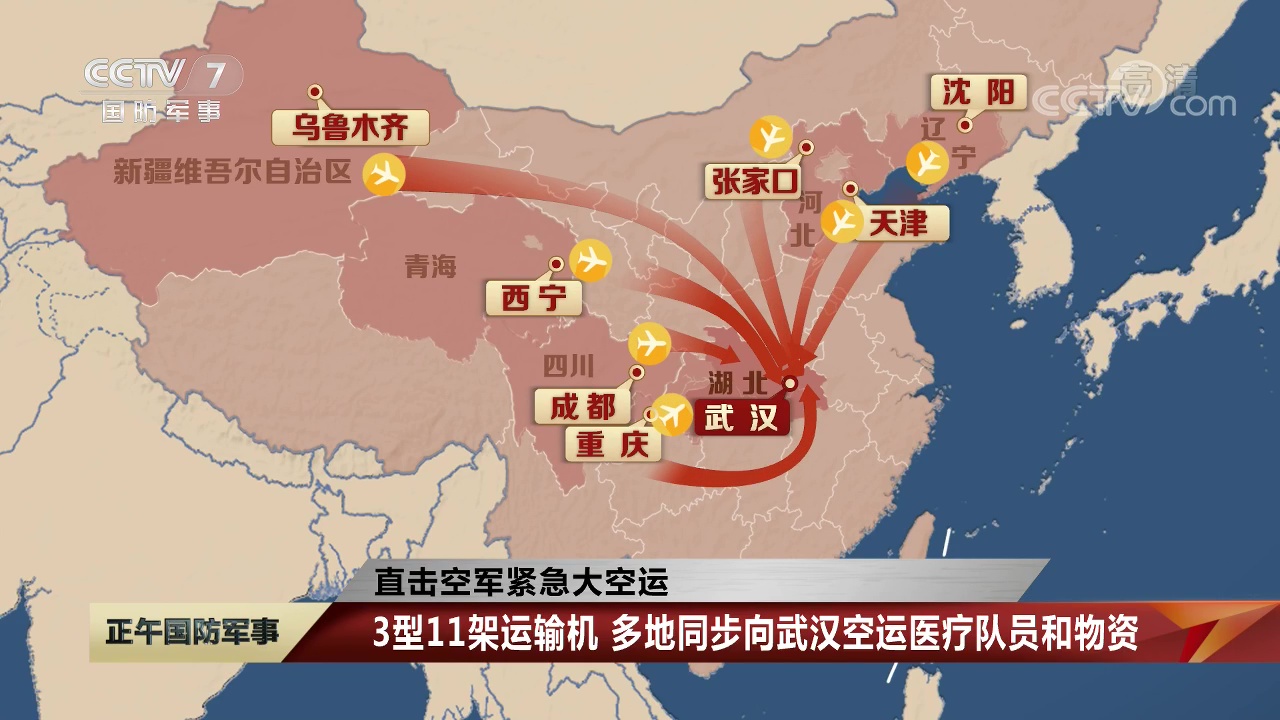
The 11 transport planes joined the 7 stopovers before leaving for Wuhan (Image: CCTV)
In the public communication, the operation is presented as "a first for the Chinese air force to send its transport planes in a systemic way in a major operation of emergency transport" (空军 首次 成 体系 大规模 出动 现役 大中型 运输机 执行 紧急 大 空运 任务). It is also "a great first for the Y-20s to have been sent in a military operation other than war" (首次 参加 非 战争 军事 行动), in other words a MOOTW (Military Operations Other Than War).
The rest of the data is fragmented and they are scattered in the various texts and commentaries on television reports. On this subject There was a certain confusion at the start on the number of medical personnel sent by the 11 apparatuses, which varies between 1400, 2600 and 4000 men according to the consulted sources. But after cross-referencing dozens of press articles and television reports, the exact number is actually 947 medical personnel and 74 tonnes of equipment that were in the 11 military transport aircraft in question.
1400 is the total number of medical personnel sent on February 13 to Wuhan, knowing that some of them arrived in the city in 12 different TGV trains. 2,600 is the number of reinforcements planned in the new Chinese government measure
The figure of 4,000, in fact, is actually the total number of military medical personnel already sent by the Chinese army to Wuhan, plus those who will be there soon.
A “careful” deployment of the Y-20?
With official publications, we are able to extract, exactly or approximately, several interesting elements with regard to the distances traveled by each of the 11 aircraft, the number of personnel transported, and the mass of materials carried.
Among the 947 medical soldiers, 222 were on board two Y-20s registered 11055 and 11059 which flew Qionglai-Chongqing-Wuhan, and "nearly 200" on two other Y-20s registered 20041 and 20042. The number passengers on the last two Y-20s, 11058 and 11150, remain unknown.
Based on the figures known on the other aircraft and some in extrapolation, we note that the six Y-20 could have transported 60% of the passengers, that is to say approximately 569 military personnel, 29% / 272 for the three IL-76MD, and 11 % / 106 for the two Y-9 of lower caliber.
We deduce that in terms of personnel transport capacity, there would not be a significant difference between the Y-20 and the IL-76MD, which remains consistent knowing the carrying capacity of these two aircraft. transport. The only "difference" is that China has had great difficulty in obtaining IL-76MDs, even those on occasion, when the Y-20 has already entered series production. On this last point, , but this remains to be confirmed.
And the observation is astonishing - the three IL-76MD made approximately 54% of the total distance traveled by all 11 aircraft, which is normal given that two of them, registered 21041 and 21047, each flew more than 2500 km their base located in Dangyang towards Urumqi, in Xinjiang province, before leaving for Wuhan for an additional 2,700 km.
The third IL-76MD, which provided the Dangyang-Shenyang-Wuhan route, covered just over 3000 km, still in a straight line distance.
On average, the three IL-76MDs each covered 4,584 km during the night of February 12 to 13. This figure is 2,312 km for the Y-9, and only 1,203 km for the six Y-20.
Knowing that the Y-20 has a range at least equivalent to that of IL-76MD, the explanation of this distance difference and this choice of deployment remains an interesting point to explore.
Anyway, it would seem that the units operating Y-20s are in good condition - According to one of the wing chiefs, the crews were informed of the mission on the evening of February 12. If this is true, then it means that they only had a few hours to prepare their flights.
He considered it a success.
Six Y-20 in Wuhan: analysis of the first figures
BY
For China's security and defense observers, 2020 was off to a good start with a series of admissions to active service by the Chinese Navy. But the spread since mid-January of the 2019-nCoV coronavirus, now renamed CODIV-19 by the WHO, has literally saturated all the media around the world, including and especially in China, while the disease has affected far fewer people compared to the flu - As an example, there are already at least 26 million cases of influenza, 250,000 hospitalizations and 14,000 deaths in the United States since last September, according (CDC).
In this "dark" and strange time, if there is no shortage of news about the Chinese army ( We now know that the Chinese army is almost omnipresent in the search for solutions to identify and fight against the disease, and especially on the ground also to reinforce the civilian medical teams on the spot, very fragile given the scale of this epidemic ), they are especially focused on the "value of man" and the mobilization of the military medical forces in this event, and very little on the technical means deployed.
But that changes with the deployment of 11 military transport planes last Thursday in a large-scale transport operation bound for Wuhan. This event in fact gives an unexpected opportunity to study closely the capacity and the performance of the Y-20, thanks to the numerous publications produced by institutional press organs.
Since a little over 3 years ago, in July 2016, this locally designed heavy transport aircraft has shown little, or not enough, to the public, not to mention the technical data that is rarely revealed.
Six Y-20s in one MOOTW operation
As far as we know, this air operation dated Thursday, February 13, 2020 is part of an additional measure recently decided by the Chinese government and the Central Military Commission (CMC), to help the city of Wuhan. and Hubei province with medical reinforcements in men and materials.
In summary, the Chinese Air Force had mobilized 11 of its military transport aircraft in the operation, including six Y-20s, three IL-76MDs of Russian origin, and two Y-9s of medium capacity.
The aircraft come from 2 distinguished transport divisions - the 4th division based in Sichuan province for the two Y-9s and four of the six Y-20s, and the 13th division based in Hubei (three IL-76MD) and Henan (two Y-20) - and they were first sent on the night of February 12 to 13 to 7 different cities in China (Urumqi, Shenyang, Xining, Tianjin, Zhangjiakou, Chengdu and Chongqing) from their respective bases, to collect the medical teams and cargo, before leaving for Wuhan.
We also learn that the 11 planes all arrived at Tianhe International Airport in Wuhan in a fixed window. According to institutional sources, the first Y-20 landed at 08:58 local time and all other landings took place before 09:30. It is unclear, however, whether the Y-20 landed at 8:58 a.m. was also the very first in the fleet to land.

The 11 transport planes joined the 7 stopovers before leaving for Wuhan (Image: CCTV)
In the public communication, the operation is presented as "a first for the Chinese air force to send its transport planes in a systemic way in a major operation of emergency transport" (空军 首次 成 体系 大规模 出动 现役 大中型 运输机 执行 紧急 大 空运 任务). It is also "a great first for the Y-20s to have been sent in a military operation other than war" (首次 参加 非 战争 军事 行动), in other words a MOOTW (Military Operations Other Than War).
The rest of the data is fragmented and they are scattered in the various texts and commentaries on television reports. On this subject There was a certain confusion at the start on the number of medical personnel sent by the 11 apparatuses, which varies between 1400, 2600 and 4000 men according to the consulted sources. But after cross-referencing dozens of press articles and television reports, the exact number is actually 947 medical personnel and 74 tonnes of equipment that were in the 11 military transport aircraft in question.
1400 is the total number of medical personnel sent on February 13 to Wuhan, knowing that some of them arrived in the city in 12 different TGV trains. 2,600 is the number of reinforcements planned in the new Chinese government measure
The figure of 4,000, in fact, is actually the total number of military medical personnel already sent by the Chinese army to Wuhan, plus those who will be there soon.
A “careful” deployment of the Y-20?
With official publications, we are able to extract, exactly or approximately, several interesting elements with regard to the distances traveled by each of the 11 aircraft, the number of personnel transported, and the mass of materials carried.
Among the 947 medical soldiers, 222 were on board two Y-20s registered 11055 and 11059 which flew Qionglai-Chongqing-Wuhan, and "nearly 200" on two other Y-20s registered 20041 and 20042. The number passengers on the last two Y-20s, 11058 and 11150, remain unknown.
Based on the figures known on the other aircraft and some in extrapolation, we note that the six Y-20 could have transported 60% of the passengers, that is to say approximately 569 military personnel, 29% / 272 for the three IL-76MD, and 11 % / 106 for the two Y-9 of lower caliber.
We deduce that in terms of personnel transport capacity, there would not be a significant difference between the Y-20 and the IL-76MD, which remains consistent knowing the carrying capacity of these two aircraft. transport. The only "difference" is that China has had great difficulty in obtaining IL-76MDs, even those on occasion, when the Y-20 has already entered series production. On this last point, , but this remains to be confirmed.
-
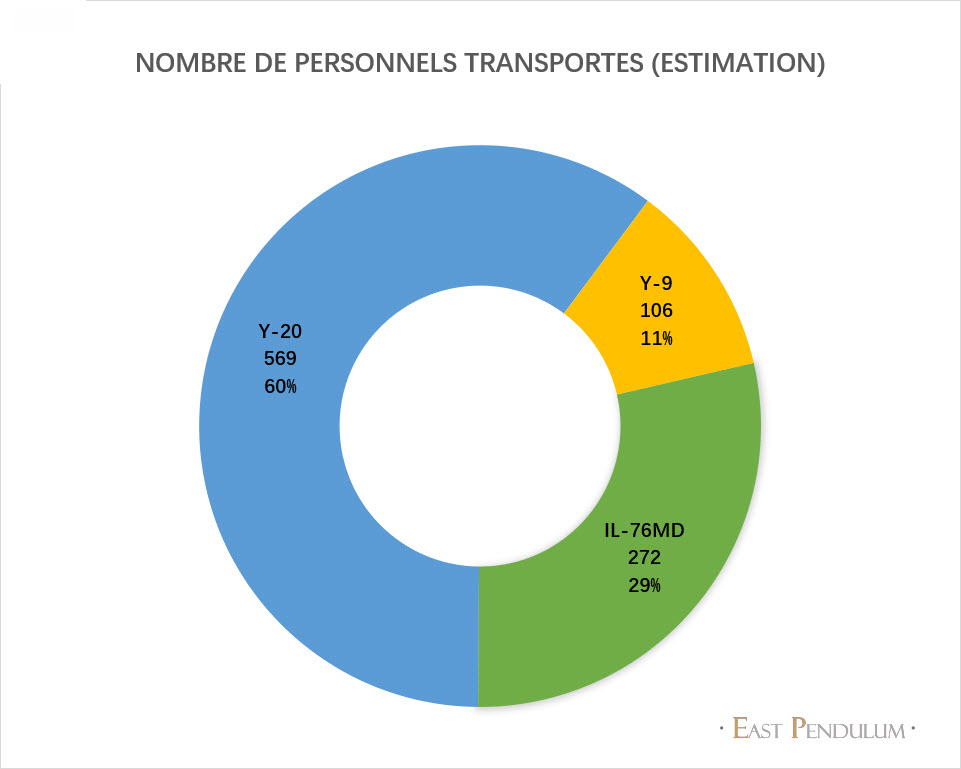
Source: East Pendulum -
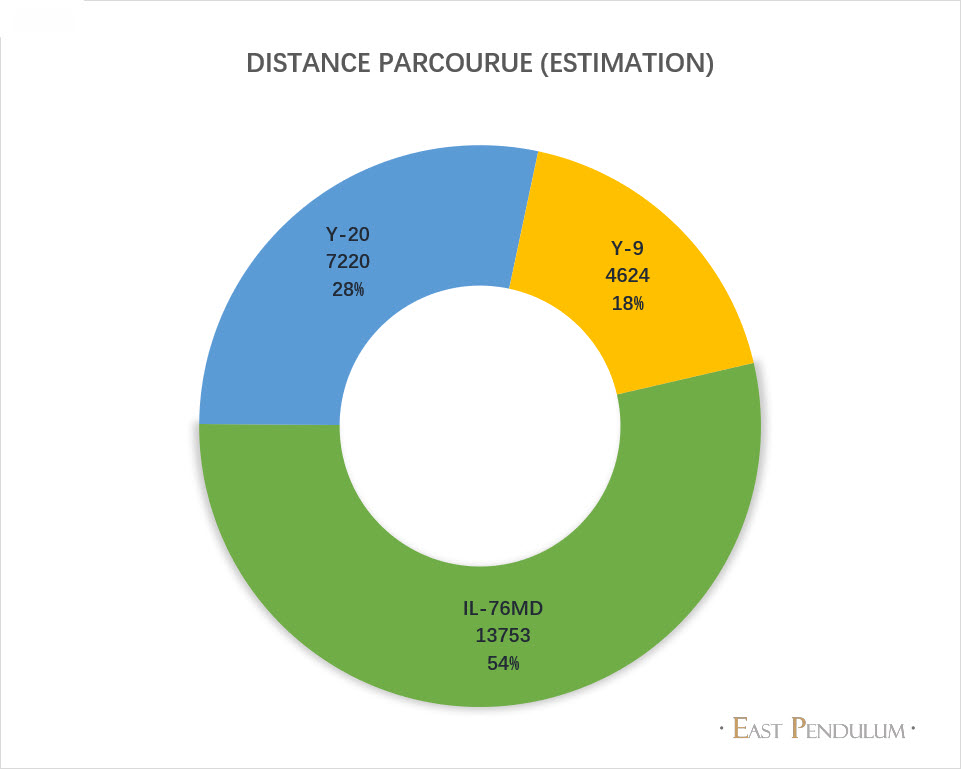
Source: East Pendulum
And the observation is astonishing - the three IL-76MD made approximately 54% of the total distance traveled by all 11 aircraft, which is normal given that two of them, registered 21041 and 21047, each flew more than 2500 km their base located in Dangyang towards Urumqi, in Xinjiang province, before leaving for Wuhan for an additional 2,700 km.
The third IL-76MD, which provided the Dangyang-Shenyang-Wuhan route, covered just over 3000 km, still in a straight line distance.
On average, the three IL-76MDs each covered 4,584 km during the night of February 12 to 13. This figure is 2,312 km for the Y-9, and only 1,203 km for the six Y-20.
Knowing that the Y-20 has a range at least equivalent to that of IL-76MD, the explanation of this distance difference and this choice of deployment remains an interesting point to explore.
Anyway, it would seem that the units operating Y-20s are in good condition - According to one of the wing chiefs, the crews were informed of the mission on the evening of February 12. If this is true, then it means that they only had a few hours to prepare their flights.
Amazing photos! Wonder what is the progress of WS-20, it should be around the corner..
Hendrik_2000
Lieutenant General
Here is the video of the air operation





